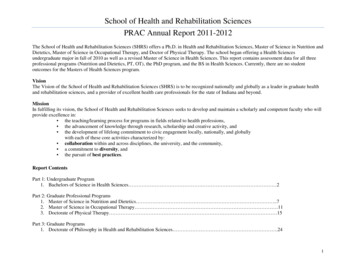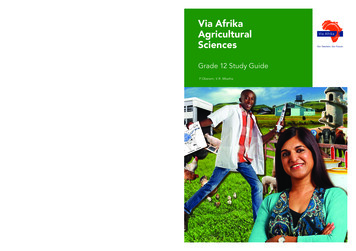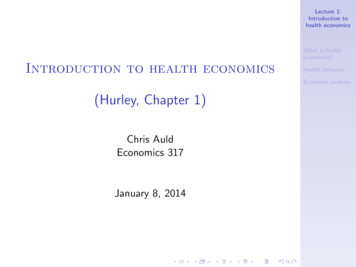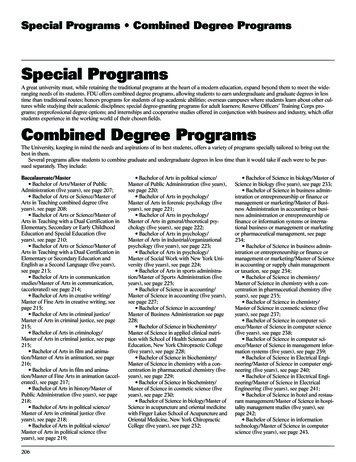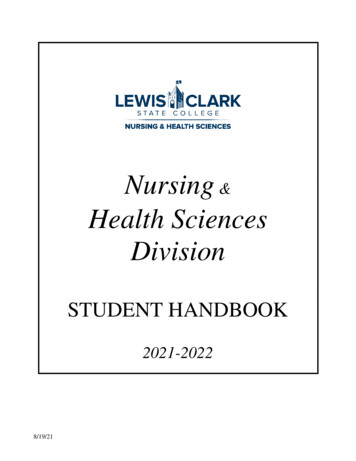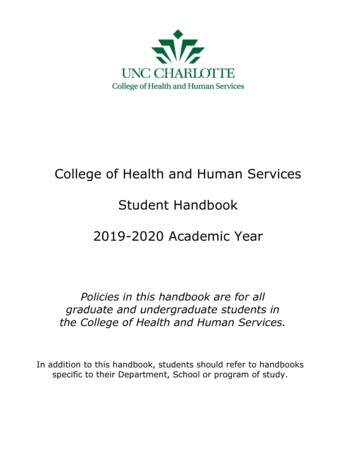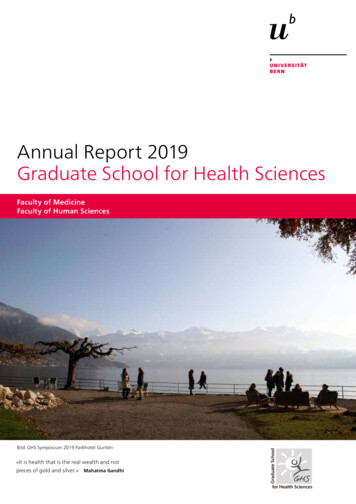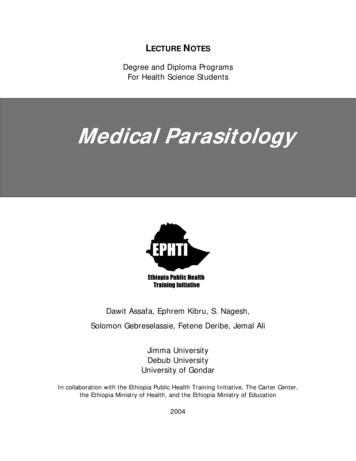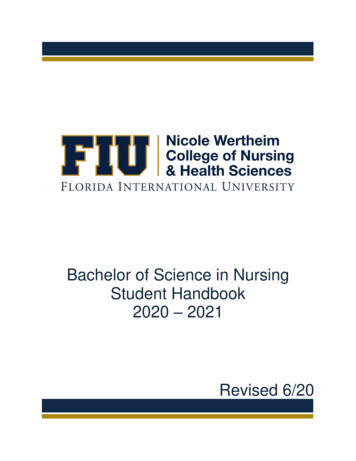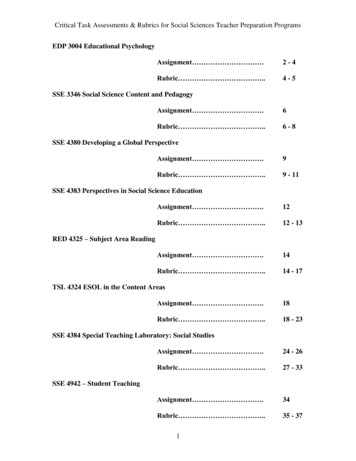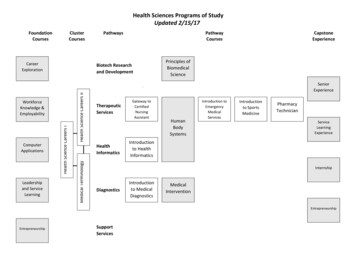
Transcription
Health Sciences Programs of StudyUpdated ationHealth Science Careers IIHealth Science Careers ICapstoneExperiencePrinciples icesHealthInformaticsMedical TerminologyLeadershipand ServiceLearningPathwayCoursesBiotech Researchand DevelopmentWorkforceKnowledge &EmployabilityComputerApplicationsPathwaysGateway ction toEmergencyMedicalServicesIntroductionto erienceIntroductionto to hipEntrepreneurshipSupportServices
Health Science Careers ICareer ClusterCourse CodePrerequisite(s)CreditGraduation RequirementProgram of Study andSequenceStudent OrganizationCoordinating Work-BasedLearningIndustry CertificationsDual Credit or DualEnrollmentTeacher CertificationResourcesHealth Science14001None1.0NoneFoundation Course – Health Science Careers I – Health Science Careers II or Medical Terminology – PathwayCourseFuture Health Professionals (HOSA), Skills USAJob shadowing, mentoring, service learning, internship, workplace toursState and National Future Health Professionals, Conference, State and National Skills USA ConferenceCourse Description:Health Science Careers I explores the current teamwork approach in health science and career options in an ever-expanding healthcareenvironment. Students in the course will evaluate unique abilities and explore personal career aspirations. In addition, the student will beexposed to legal, ethical, and safety implications inherent to providing high quality patient care.Program of Study Application:Health Science Careers I is the first cluster course in the Health Science career cluster. Completion of Health Science Careers I prepares a studentto participate in Health Science Careers II or Medical Terminology and then pathway courses in any of the Health Science pathways: BiotechResearch and Development, Therapeutic Services, Health Informatics, Diagnostics or Support Services.1
Career Cluster: Heath ScienceCourse: Health Science Careers ICourse StandardsHSI 1: Understand the healthcare setting networks and roles and responsibilities.Webb LevelTwoSkill/ConceptSub-indicatorHSI 1.1 Differentiate between private and public/government healthcaresettings (managed care).Integrated ContentInvite guest speakers(healthcare professionals),and tour healthcarefacilities.TwoSkill/ConceptHSI 1.2 Collaborate and communicate effectively with colleagues,patients/residents, and/or family members.Speaking and listeningskills in teamwork, roleplaying,ThreeStrategicThinkingHSI 1.3 Classify personal traits or attitudes desirable in a member of the healthcaresetting.Select a health sciencecareer pathway that is ofinterest.Notes2
Career Cluster: Heath ScienceCourse: Health Science Careers IHSI 2: Identify health science career pathways.Webb LevelTwoSkill/ConceptSub-indicatorHSI 2.1 Identify and compare health science career pathways.Integrated ContentAttend career fairs, fieldtrips, and guest speakers(healthcare professionals).Classify careers in eachhealth science pathway.OneRecallHSI 2.2 Demonstrate knowledge of levels of education and credentialing requirements for avariety of health science careers of interest.Research post-secondaryoptions and degrees, inviteguest speakers, andresearch state and nationalcredentialing requirements.OneRecallHSI 2.3 Explore and demonstrate knowledge of employment opportunities,workplace environments, and career growth potential.Job shadowing andmentoring. Workplacetours, service learning.Invite guest speakers.Notes3
Career Cluster: Heath ScienceCourse: Health Science Careers IHSI 3: Examine legal/ethical responsibilities and limitations of the healthcare worker.Webb LevelSub-indicatorThreeHSI 3.1 Understand legal/ethical issues, religious and cultural diversity and their impacts onStrategic Thinking health care.Integrated ContentExamine case studies, andstudent led presentations.ThreeHSI 3.2 Understand scope of practice and a variety of professional standards including theStrategic Thinking American Medical Association, American Nurse Association, American Dental Association.Review American MedicalAssociation code of ethics,review American NursesAssociation code of ethics.ThreeHSI 3.3 Examine the implications of Health Insurance Portability and Accountability ActStrategic Thinking (HIPAA) for healthcare professionals.Health Insure Portabilityand Accountability Act(HIPAA) training throughlocal healthcare facility.ThreeHSI 3.4 Analyze Patient/Residents' Bill of Rights and advanced directives.Strategic ThinkingRole playing, casescenarios, research, inviteguest speakers.Notes4
Career Cluster: Heath ScienceCourse: Health Science Careers IHSI 4: Understand and demonstrate safety practices in the healthcare environment.Webb LevelTwoSkill/ConceptSub-indicatorHSI 4.1 Apply principles of body mechanics and ergonomics.Integrated ContentOccupational Safety HealthAdministration (OSHA),practice on mannequins,role playing, and returnskills demonstrations.TwoSkill/ConceptHSI 4.2 Identify common safety hazards in the healthcare environment includingpatient/resident, community, and healthcare worker settings.Return skillsdemonstrations, practicesafety procedures ofvarious hazards in thehealthcare environment.Occupational Safety HealthAdministration (OSHA).Notes5
Health Science Careers IICareer ClusterCourse CodePrerequisite(s)CreditGraduation RequirementProgram of Study andSequenceStudent OrganizationCoordinating Work-BasedLearningIndustry CertificationsDual Credit or DualEnrollmentTeacher CertificationResourcesHealth Science14002Health Science Careers I1.0NoneFoundation Course – Health Science Careers I – Health Science Careers II – Medical Terminology or PathwayCourseFuture Health Professionals (HOSA) , Skills USAWorkplace tours, job shadowing, mentoring, service learning, internshipFirst Aid, Cardiopulmonary Resuscitation (CPR), Automated External Defibrillator (AED) , Certified NurseAssistant (CNA).State and National Future Health Professionals (HOSA) Conference (Competitive events), State and NationalSkills USA Conference, American Red Cross, and American Heart Association.Course Description:Health Science Careers II will help a student discover and develop marketable and real world skills that are essential to all health care workers.This course will cover real world skills such as infection control, disease, diagnosis, treatment, hands on skills, and documentation.Program of Study ApplicationHealth Science Careers II is the second cluster course in the Health Science career cluster. Completion of Health Science Careers II prepares astudent to participate in Medical Terminology and/or a pathway courses in any of the Health Science pathways: Biotech Research andDevelopment, Therapeutic Services, Health Informatics, Diagnostics or Support Services.1
Career Cluster: Health ScienceCourse: Health Science Careers IICourse StandardsHS2 1: Identify and apply principles of infection control.Webb LevelSub-indicatorThreeHS2 1.1 Discuss the chain of infection.Strategic ThinkingIntegrated ContentReturn skillsdemonstration, and guestspeakers (healthcareprofessionals).TwoSkill/ConceptReturn skillsdemonstration, and inviteguest speakers, simulationlab.HS2 1.2 Understand and apply the prevention of pathogen transmission.Notes2
Career Cluster: Health ScienceCourse: Health Science Careers IIHS2 2: Discuss disease, diagnosis, and treatment.Webb LevelSub-indicatorThreeHS2 2.1 Discuss disease concept with reference to Centers for Disease Control and NationalStrategic Thinking Institute of Health.Integrated ContentSimulation lab, casescenarios, and return skillsdemonstration.ThreeHS2 2.2 Evaluate and assess patient/residents' health.Strategic ThinkingSimulation lab, casescenarios, and return skillsdemonstration.Simulation lab, casescenarios for acute andchronic patient/residentconditions, and return skillsdemonstration.OneRecallHS2 2.3 Recognize current treatment modalities including but not limited to obesity, heartdisease, cancer, and respiratory.Notes3
Career Cluster: Health ScienceCourse: Health Science Careers IIHS2 3: Demonstrate hands-on patient/residents' care skills.Webb LevelTwoSkill/ConceptSub-indicatorHS2 3.1 Apply procedures for monitoring, measuring, and recording vital signs.TwoSkill/ConceptHS2 3.2 Apply First Aid/Cardiopulmonary Resuscitation (CPR), and Automated ExternalDefibrillator (AED).TwoSkill/ConceptHS2 3.3 Demonstrate knowledge of direct patient/residents' care skills.Integrated ContentSimulation lab, return skillsdemonstrations,certifications.Simulation lab,certifications, and returnskills demonstration,workplace tours, inviteguest speakers.Simulation lab, casescenarios, and return skillsdemonstration, student ledpresentations, internship,job shadowing.Notes4
Career Cluster: Health ScienceCourse: Health Science Careers IIHS2 4: Explain documentation standards and findings.Webb LevelSub-indicatorThreeHS2 4.1 Demonstrate use of technological documentation standards by entering data onStrategic Thinking the electronic medical record or paper.Integrated ContentPractice charting graphs,tables, diagrams on paperor Electronic MedicalRecord (EMR).ThreeStrategicThinkingPatient assessments andinterviews, case scenarios,simulation labHS2 4.2 Differentiate between subjective and objective healthcare data to communicatepatient/residents' status.Notes5
Medical TerminologyCareer ClusterCourse CodePrerequisite(s)CreditGraduation RequirementProgram of Study andSequenceStudent OrganizationCoordinating Work-BasedLearningIndustry CertificationsDual Credit or DualEnrollmentTeacher CertificationResourcesHealth Science14154None1.0NoFoundation Course – Health Science Careers I – Health Science Careers II or Medical Terminology – PathwayCourseFuture Health Professionals (HOSA) , Skills USAMentoring, job shadowing, internship, workplace tours, service learningState and National Future Health Professionals (HOSA) Conference (Competitive Events), State and NationalSkills USA ConferenceCourse Description:Communication in the ever expanding health care industry is a language unto itself. Medical Terminology consists of learning medically precisepronunciations, word clues, and terminology specific to human anatomy, physiology, disease, diagnosis and treatment. This medically integratedknowledge will be valuable for all levels of health care providers and members of the health care team. Medical Terminology is recommendedfor students in all health science pathways.Program of Study ApplicationMedical Terminology is a second cluster course in the Health Science career cluster. Completion of Medical Terminology prepares a student toparticipate in Health Science Careers II and/or a pathway courses in any of the Health Science pathways: Biotech Research and Development,Therapeutic Services, Health Informatics, Diagnostics or Support Services.1
Career Cluster: Health ScienceCourse: Medical TerminologyCourse StandardsMT 1: Build and interpret medical terminology.Webb LevelOneRecallSub-indicatorMT 1.1 Decipher and create medical terms using word roots, prefixes, and suffixes.Integrated ContentFlashcards, competitivestrategies, games, quizzing.OneRecallMT 1.2 Demonstrate the importance, and practice the correct spelling, of medicalterminology.Written testing, quizzing,spelling games,TwoSkill/ConceptMT 1.3 Communicate patient/residents’ care information utilizing medical terminology.Practice mock charting,case scenarios.Notes2
Career Cluster: Health ScienceCourse: Medical TerminologyMT 2: Demonstrate use of medical terminology in relation to the human body.Webb LevelTwoSkill/ConceptSub-indicatorMT 2.1 Utilize medical terminology associated with the human body and medicalhealthcare treatment.Integrated ContentFlashcards, competitivestrategies, games, quizzing.TwoSkill/ConceptMT 2.2 Understand body planes, directional terms, quadrants, and cavities using medicalterminology.Flashcards, competitivestrategies, games, quizzing.Notes3
Career Cluster: Health ScienceCourse: Medical TerminologyMT 3: Utilize medical terminology to identify and interpret signs and symptoms of diseases and disorders.Webb LevelTwoSkill/ConceptSub-indicatorMT 3.1 Utilize medical terminology to compare and contrast symptoms of diseases anddisorders.Integrated ContentFlashcards, competitivestrategies, games, quizzing.TwoSkill/ConceptMT 3.2 Utilize medical terminology pertaining to diagnosis and treatment of diseases anddisorders in patients/residents.Flashcards, competitivestrategies, games, quizzing,case scenarios.Notes4
Gateway to Certified Nursing AssistantCareer ClusterCourse CodePrerequisite(s)CreditGraduation RequirementProgram of Study andSequenceStudent OrganizationsCoordinating Work-BasedLearningIndustry CertificationsDual Credit or DualEnrollmentTeacher CertificationResourcesHealth Science140511.0NoneCluster course – Gateway to Certified Nursing Assistant – other pathway courses in the Therapeutic Servicespathway or capstone experienceFuture Health Professionals (HOSA), Skills USAMentoring, Job Shadowing, Internship, Workplace Tours,Certified Nursing AssistantState and National Future Health Professionals (HOSA) Conference (Competitive Events), State and NationalSkills USA Conference, Certified Nursing Assistant Candidate Handbook, Omnibus Budget Reconciliation Act,South Dakota Board of Nursing, South Dakota Healthcare Association.Course Description:Gateway to Certified Nursing Assistant is designed to empower high school students to take charge of and set a course for their future. It willprepare them to graduate with marketable skills and a real-world work connection. Students will be informed of the roles of the CertifiedNursing Assistant focusing on direct patient care. After completing this portion for the Certified Nursing Assistant course a student would needonly to pass the state examinations in order to become a Certified Nursing Assistant. Clinical hours may be required to meet certificationrequirements.Program of Study ApplicationGateway to Certified Nursing Assistant is the first pathway course in the Health Science career cluster, Therapeutic Services pathway. The coursewould follow participation in one or more cluster courses. Completion of Gateway to Certified Nursing Assistant would prepare a student toparticipate in further pathway courses in the Therapeutic Services pathway or a capstone experience.1
Career Cluster: Health ScienceCourse: Certified Nursing AssistantCourse StandardsCNA 1: Discuss the Certified Nursing Assistant (CNA) certification process and roles of the CNA in the healthcare environment.Webb LevelOneRecallSub-indicatorCNA 1.1 Discuss laws and regulations that govern the work and certification of the nurseassistants.Integrated ContentDiscuss Future HealthProfessionals, Skills USA,Omnibus BudgetReconciliation Act, SouthDakota Board of Nursing,South Dakota HealthcareAssociation.OneRecallCNA 1.2 Identify the job duties and requirements of a nurse assistant.Discuss South Dakota Boardof Nursing, South DakotaHealthcare Association.Discuss the CandidateCertified Nursing AssistantHandbook.Notes2
Career Cluster: Health ScienceCourse: Certified Nursing AssistantCNA 2: Identify and implement principles related to infection control and basic safety/emergency situations.Webb LevelOneRecallSub-indicatorCNA 2.1 Identify Certified Nursing Assistant’s role in infection control procedures inreference to Centers for Disease Control, Occupational Safety Health Administration, andNational Institute of Health.Integrated ContentHands on skills practice,and return skillsdemonstration.Compare the relationshipbetween microorganismsand infections includingbody and defenses.TwoSkill/ConceptCNA 2.2 Discuss and demonstrate safety procedures within the healthcare environment.Understand OccupationalSafety HealthAdministration (OSHA),Material Safety DataSheet/Safety Data Sheet.Notes3
Career Cluster: Health ScienceCourse: Certified Nursing AssistantCNA 3: Measure and record patient/resident’s health-related vital data/statistics.Webb LevelTwoSkill/ConceptSub-indicatorCNA 3.1 Collect and document baseline information, including vital signs, height andweight.Integrated ContentHands on skills, return skillsdemonstration with heightand weight, oxygensaturation, pain ratingscale, and vital signs.TwoSkill/ConceptCNA 3.2 Identify normal ranges for vital signs, and list factors which can affect vital signs.Hands on skills, return skillsdemonstration.Understand the list factorsthat can affect theminclude infection, caffeine,stress, medications, pain.Notes4
Career Cluster: Health ScienceCourse: Certified Nursing AssistantCNA 4: Understand patient/resident’s environment, basic human needs, and the importance of hygiene.Webb LevelTwoSkill/ConceptSub-indicatorCNA 4.1 Identify the importance of basic physical human needs of the patient/resident.Integrated ContentUnderstand basicknowledge ofpatient/resident’s basicphysical human needs suchas activities of daily livingTwoSkill/ConceptCNA 4.2 Identify the importance of the patient/resident’s psychosocial needs.Understand basicknowledge ofpatient/resident’spsychosocial needs such asMaslow’s Hierarchy ofNeeds, aging process,Department of SocialServices, sensitivity toreligious and culturalbeliefs, empathy, andmental well-being.Notes5
Career Cluster: Health ScienceCourse: Certified Nursing AssistantCNA 5: Understand care involving cognitive impairment, mental illness, and death and dying.Webb LevelTwoSkill/ConceptSub-indicatorCNA 5.1 Identify effective strategies when caring for cognitively altered and mentally illpatients.Integrated ContentUnderstanding commonmental illness conditionsand characteristics such asdementia, Alzheimer’s,delirium, and depression.TwoSkill/ConceptCNA 5.2 Understand the basic needs and care during patient/resident’s death and grievingprocess.Describe death withdignity, summarize physicalcare of the dying patient,discuss post mortem care,and differentiate betweenvarious stages of thegrieving process.Notes6
Introduction to Emergency Medical ServicesCareer ClusterCourse CodePrerequisite(s)CreditGraduation RequirementProgram of Study andSequenceStudent OrganizationCoordinating Work-BasedLearningIndustry CertificationsDual Credit or DualEnrollmentTeacher CertificationResourcesHealth ScienceNone1NoCluster course – Gateway to Certified Nursing Assistant – Introduction to Emergency Medical Services – otherpathway courses in the Therapeutic Services pathway or capstone experienceFuture Health Professionals (HOSA), Skills USAWorkplace tours, job shadowing, mentoring, service learning, internshipFirst Aid/Cardiopulmonary Resuscitation (CPR)/Automated External Defibrillator (AED)/First Aid throughAmerican Red Cross or American Heart Association as appropriateNoHealth Science or related occupational trainingAmerican Red Cross: www.redcross.org, American Heart Association www.heart.orgCourse Description:Introduction to Emergency Medical Services is designed to expose students to the various career opportunities in the Emergency MedicalServices field. Emergency care services are necessary for the safety of the community. A network of services are coordinated to provide aid andmedical assistance from primary response to definitive care, involving personnel trained in the rescue, stabilization, transportation, andadvanced treatment of traumatic or medical emergencies. Potential career opportunities may include emergency medical dispatch, first medicalresponder, ambulance personnel, medium and heavy rescue equipment, and paramedic units. Upon completion of this course, students will betrained in First Aid, Cardio Pulmonary Resuscitation (CPR) and Automatic External Defibrillator (AED).Program of Study ApplicationIntroduction to Emergency Medical Services is a pathway course in the Health Science career cluster, Therapeutic Services pathway. The coursewould follow participation in one or more cluster courses and/or Gateway to Certified Nursing Assistant. Introduction to Emergency MedicalServices would prepare a student to participate in further pathway courses in the Therapeutic Services pathway or a capstone experience.1
Career Cluster: Health ScienceCourse: Introduction to Emergency Medical ServicesCourse StandardsEMS 1 Explore roles, responsibilities, and professionalism of Emergency Medical Services (EMS) personnel.Webb LevelTwoSkill/ConceptSub-indicatorEMS 1.1 Distinguish differences among careers within EMS and explain in detail theeducation level, credentialing/licensure requirements.Integrated ContentExamples include:paramedic, EmergencyMedical Technician (EMT),firefighter, lifeguard, etc.ThreeEMS 1.2 Demonstrate emotional support to patient, bystanders, or other responders.Strategic ThinkingIntegration with otherprofessionals andcontinuity of care (medicalpersonnel, lawenforcement, emergencymanagement, home healthcare providers, etc.)ThreeEMS 1.3 Investigate medical and legal standards in correlation with the Health InsuranceStrategic Thinking Portability & Accountability Act (HIPAA)Confidentiality, professionalethicsFourExtendedThinkingStress management, selfcare, personal pride,positive attitude, reliability,accountability, emotionalstability, sensitivity todiverse populationsEMS 1.4 Apply concepts related to professional attitude and appearanceNotes2
Career Cluster: Health ScienceCourse: Introduction to Emergency Medical ServicesEMS 2 Demonstrate skills in first aid, cardiopulmonary resuscitation (CPR) and automated external defibrillation (AED) certification standardsset by the American Heart Association or the American Red Cross.Webb LevelTwoSkill/ConceptSub-indicatorEMS 2.1 Understand how to perform First Aid for Students and/or CPR for Students and/orhow to use an AED.Integrated ContentProve understanding ofFirst Aid for Studentsand/or CPR for Studentsand/or AED certification bycompleting the course andearning a certification card.Seek out communityresources to meetcertification requirements.Notes3
Career Cluster: Health ScienceCourse: Introduction to Emergency Medical ServicesEMS 3 Determine the necessity of emergency medical care for a variety of patients with varied medical conditionsWebb LevelTwoSkill/ConceptSub-indicatorEMS 3.1 Identify emergency medical treatment protocolIntegrated ContentPhysical Assessment,oxygen administration,immobilization, vehicleextrication, trauma,environmental injury,emergency childbirth.Possible case study and roleplay opportunities forpracticeNotes4
Introduction to Health InformaticsCareer ClusterCourse CodePrerequisite(s)CreditGraduation RequirementProgram of Study andSequenceStudent OrganizationHealth ScienceCoordinating Work-BasedLearningIndustry CertificationsDual Credit or DualEnrollmentWork-Based LearningTeacher CertificationResourcesCTE certified with Health Science EndorsementAmerican Medical Informatics Association (AMIA)www.amia.orgRecommend taking Medical Terminology first1 creditNoneCluster course – Introduction to Health Informatics – Human Body Systems or capstone experienceFuture Health Professionals (HOSA), SkillsUSANoneNoneCourse Description:Health Informatics is a multidisciplinary approach to automated collection, using and sharing of personal and epidemiologic health information.The Health Informatics course will introduce students to the necessary skills and knowledge to work in places such as medical groups, hospitals,clinics, health insurance organizations, research, hardware and software vendors, internet companies, and many others.Program of Study ApplicationIntroduction to Health Informatics is the first pathway course in the Health Science career cluster, Therapeutic Services pathway. The coursewould follow participation in one or more cluster courses. Completion of Introduction to Health Informatics would prepare a student toparticipate in further pathway courses in the Health Informatics pathway or a capstone experience.1
Career Cluster: Health ScienceCourse: Introduction to Health InformaticsCourse StandardsHI 1: Communicate health information accurately and within legal and regulatory guidelines, upholding the strictest standards ofconfidentiality.Webb LevelTwoSkill/ConceptSub-indicatorHI 1.1 Apply accuracy, effectiveness and timeliness to the transfer ofinformation.Integrated ContentEmploy techniques for effectivelycommunicating health/medicalinformation within legal/regulatoryguidelines.TwoSkill/ConceptHI 1.2 Summarize how legal and regulatory requirements apply to thetransfer of information.Employ techniques for effectivelycommunicating health/medicalinformation within legal/regulatoryguidelines.TwoSkill/ConceptHI 1.3 Distinguish who in the organization needs information and whenthey need it.Employ techniques for effectivelycommunicating health/medicalinformation within legal/regulatoryguidelines.TwoSkill/ConceptHI 1.4 Organize recorded information and other documents within theHealth Insurance Portability and Accountability Act (HIPAA) protocolsto ensure confidentiality and privacy.Employ techniques for confidentiallycommunicating health/medicalinformation in compliance withlegal/regulatory guidelines.OneRecallHI 1.5 Communicate information ensuring confidentiality of content ismaintained.Employ techniques for confidentiallycommunicating health/medicalinformation in compliance withlegal/regulatory guidelines.Notes2
Career Cluster: Health ScienceCourse: Introduction to Health InformaticsHI 2: Describe the content and diverse uses of health information.Webb LevelTwoSkill/ConceptSub-indicatorHI 2.1 Interpret and extract information from medical records anddocuments.Integrated ContentEmploy techniques for effectively documenting,communicating and maintaining healthinformation within legal and regulatoryguidelines.TwoSkill/ConceptHI 2.2 Collect appropriate, accurate information including propercodes to record charges for reimbursement.Employ techniques for effectively documenting,communicating and maintaining healthinformation within legal and regulatoryguidelines.OneRecallHI 2.3 Identify and apply accurate medical terminology.Employ techniques for effectively documenting,communicating and maintaining healthinformation within legal and regulatoryguidelines.TwoSkill/ConceptHI 2.4 Determine the need for requesting further clarification whentranscribing/transferring information that may be unclear.Employ techniques for effectively documenting,communicating and maintaining healthinformation within legal and regulatoryguidelines.TwoSkill/ConceptHI 2.5 Assess and apply information for regulatory and legal purposes.Employ techniques for effectively documenting,communicating and maintaining healthinformation within legal and regulatoryguidelines.Notes3
Career Cluster: Health ScienceCourse: Introduction to Health InformaticsHI 3: Demonstrate the use of systems used to capture, retrieve and maintain confidential health information from internal and externalsources.Webb LevelSub-indicatorThreeHI 3.1 Formulate and accurately document required information.Strategic ThinkingTwoSkill/ConceptHI 3.2 Interpret information that has been collected.ThreeHI 3.3 Differentiate the purposes and audiences for whom informationStrategic Thinking is collected.TwoSkill/ConceptHI 3.4 Prepare accurate documentation for various audiences withinlegal and regulatory requirements, as requested.OneRecallHI 3.5 Disseminate information to various audiences using systemsand guidelines within the facility.TwoSkill/ConceptHI 3.6 Organize and maintain a records storage system within legalrequirements and protocols.Integrated ContentEmploy techniques for effectively documenting,communicating and maintaining healthinformation within legal and regulatoryguidelinesEmploy techniques for effectively documenting,communicating and maintaining healthinformation within legal and regulatoryguidelinesEmploy techniques for effectively documenting,communicating and maintaining healthinformation within legal and regulatoryguidelinesEmploy techniques for effectively documenting,communicating and maintaining healthinformation within legal and regulatoryguidelinesEmploy techniques for effectively documenting,communicating and maintaining healthinformation within legal and regulatoryguidelinesEmploy techniques for effectively documenting,communicating and maintaining healthinformation within legal and regulatoryguidelinesNotes4
Introduction to Medical DiagnosticsCareer ClusterCourse CodePrerequisite(s)CreditGraduation RequirementProgram of Study andSequenceStudent OrganizationCoordinating Work-BasedLearningIndustry CertificationsDual Credit or DualEnrollmentTeacher CertificationResourcesHealth ScienceNone1 creditNoneCluster course – Introduction to Medical Diagnostics – Medical Intervention or capstone experienceFuture Health Professionals (HOSA) & Skills USAWork-Based Learning: Job Shadowing and InternshipNoneNoneCTE certified with Health Science EndorsementLocal healthcare facilityCourse Description: Diagnostic services creates a picture of the health status of a patient at a single point in time. Introduction to MedicalDiagnostics will address tests and evaluations that aid in the detection, diagnosis, and treatment of disease, injury, or other phys ical conditions.Program of Study ApplicationIntroduction to Medical Diagnostics is the first pathway course in the Health Science career cluster, Diagnostics pathway. The course wouldfollow participation in one or more cluster courses. Completion of Introduction to Health Informatics would prepare a student to participate inMedical Intervention or a capstone experience.1
Career Cluster: Health CareersCourse: Introduction to Medical DiagnosticsCourse StandardsIMD 1: Investigate Diagnostic Pathway careers.Webb Level
Assistant (CNA). Dual Credit or Dual Enrollment Teacher Certification Resources State and National Future Health Professionals (HOSA) Conference (Competitive events), State and National Skil
